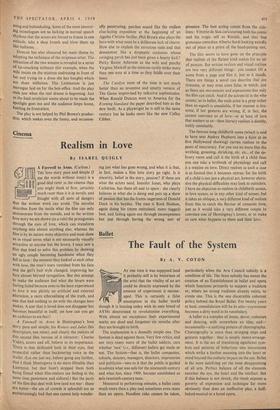Ballet
The Fault of the System
By A. V. COTON The explanation is a dismally simple one. The System is dead against them. Very few critics, and not very many more of the ballet addicts, care whether 'new' (i.e., different) ballets get made or not. The System—that is, the ballet companies, schools, dancers, managers, directors, impresarios and publicists—sees to it that the public is guided to admire what was safe for the nineteenth century and what has, since 1909, become established as safe twentieth-century taste.
Measured in performing minutes, a ballet costs much more than a play and sometimes even more than an opera. Needless risks cannot be taken, particularly when the Arts Council subsidy is a condition of life. The State subsidy has meant the creation of an Establishment in ballet and opera which functions primarily to support a tradition or, where no strong tradition already exists, to create one. This is the one discernible coherent policy behind the Royal Ballet. For twenty years at least, consolidation will be its aim—experiment becomes a dirty word in its vocabulary.
A ballet is a complex of music, decor, costumes and dancing, with somewhere an idea, and- occasionally—a unifying pattern of choreography. Choreography is more than stringing steps and gestures together : that is simply dance-arrange- ment. It is the act of translating significant sym- bols and patterns of behaviour into movements which strike a further meaning into the heart or mind beyond the aesthetic impact on the eye. Ballet is the most satisfying yet the most disappointing of all arts. Perfect balance of all the elements enriches the eye, the heart and the intellect. But if this balance is not struck, the result exposes a poverty of expression and technique far more obviously than does an ineffective play, a half- baked musical or a banal opera. There Is vitality in English ballet today, But this vitality is more like that of the ant-heap than of a community of humans trying to illuminate the fantasy of existence. This is inevitable within the System as it stands today. The public is educated to accept the well-publicised values of the manage- ments, impresarios and directors for whom a good ballet is a reproduction of a full-length nineteenth- century `classic,' and a second-best ballet a pale copy of an early-Diaghilev masterpiece. Beyond this, the repertoires are loaded with ballets (whether they looked experimental or not When first created) which are tentatively Modelled on the ideals and idioms established by Fokine fifty years ago. The trouble is that the young workers in this field have rarely been taught what really arc the ideals and idioms of the" Fokine Era. Under such conditions itis a marvel that so many youngsters, turn Out an occasionally, successful ballet. It is no surprise that, after a dozen or so performances, they reveal flaws of structure which in the course of a year or two kill off most of them. The few which are revived achieve this through managerial gambling, or because the choreographer is important enough (usually as a dancer) to insist on a resurrection.
This revival has 'recently been achieved by some of the war-time 'ballets of Robert Helpmann. Miracle in the Gorbals. and Handet both wear their years heavily. Both reveal with eye-searing clarity that their success during the war years hung on two simple facts: that Helpmann himself was mainly impressive as a mime with a violent yet uncomplex technique and little dancing ability, and that those times welcomed any sort of novel balletic theme. Gorbals is the story of Christ re- turning, doing good, and being re-crucified. Hamlet investigates only what flashes through the dying Prince's mind during his final minute of life. Today the thinness of the choreography, their reliance on anaemic mime rather than on full- blooded dancing, 'and their blurred symbolism,' make one wonder why they wete disinterred.
The other recent bout of `experimentalism' occurred at the Sunday Ballet Club at Wyndham's Theatre. The programme contained two conven- tional little ballets, one a neatly empty paraphrase of a hundred predecessors, the other (Affair) with some bones of real human observation in it. The only unconventional work was a reworking of Brecht's Good Woman of Szechuan. This was, in the circumstances of today, heart-breaking with its desperate striving after elfect—a would-be atonal score, a Child-Art decor mingling atom rockets, pin-table saloons, factories and huts in a China farther away than that of the Shang Dynasty. All this was carried out in a style crammed with eccentric gestures and posturings "which anyhow lacked dramatic projection. No recent experimental ballet has so fully pointed the need for a -true laboratory of dance-art. This could change the style and direction (and the general level of taste, too) of our ballet within five years: It could lead to that kind of drama- ballet which we urgently need. But this cannot conic about until the preient leadership of all our ballet enterprises decides to accept the responsi- bilities of leadership. With two honourable excep- tions, they are all too busy consolidating a tradi- tion which entirely lacks roots in our contem- porary way of life.































 Previous page
Previous page